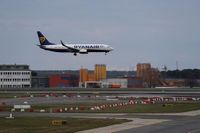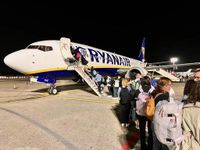Ryanair, Europe’s largest low-cost airline, has found itself at the center of a turbulent season—literally and figuratively—as it navigates operational challenges, strategic expansions, and shifting regulatory headwinds across the continent. The Irish carrier’s resilience and adaptability are being tested by everything from severe storms and fuel emergencies to disputes over airport fees and ambitious growth plans in key markets.
On October 3, 2025, a Ryanair flight traveling from Pisa to Glasgow Prestwick narrowly avoided disaster when it was forced to make an emergency landing in Manchester. The aircraft, a Boeing 737-800 operated by Malta Air for Ryanair, found itself caught in the throes of Storm Amy, which battered the UK with winds reaching up to 160 kilometers per hour. According to reports in Corriere della Sera and confirmed by the UK’s Air Accidents Investigation Branch (AAIB), the flight, designated FR3418, attempted to land twice at Prestwick but was thwarted by unrelenting winds. The pilots then diverted to Edinburgh, only to be met with similarly treacherous weather, forcing them to abandon that approach as well.
With fuel reserves dwindling, the crew made the critical decision to divert yet again, this time to Manchester. As the situation escalated, the pilots declared an emergency by transmitting the squawk code 7700—a universal signal for in-flight distress. When the plane finally touched down in Manchester, it had been in the air for four and a half hours, nearly double the usual flight time for that route. The aircraft’s tanks contained just 220 kilograms of fuel—enough to keep flying for only five or six more minutes, according to the Corriere della Sera report.
The AAIB has since launched an investigation to determine whether there were miscalculations or procedural errors in the flight’s planning and fuel management. Ryanair responded promptly, notifying authorities on the same day and pledging full cooperation. A spokesperson stated, “As the matter is now under investigation, and we are cooperating fully, we are unable to make further comment at this time.”
While this emergency landing highlighted the unpredictable risks of aviation, especially during extreme weather, Ryanair’s broader strategy has been to expand aggressively where conditions allow—and to pull back where regulatory or economic pressures bite. Nowhere is this more evident than in Spain, where the airline is simultaneously ramping up operations in some regions while cutting back in others.
Starting October 26, 2025, Ryanair will expand its presence at Valencia Airport for the winter season, offering 2.1 million seats and operating 50 routes until March 29, 2026. This marks an 8% increase in available seats compared to the previous winter and a rise in weekly departures from 239 to 260. New connections to Poznan (Poland), Pescara (Italy), and Edinburgh (Scotland) will continue through the winter, each operating twice weekly. The airline expects to carry approximately 5.3 million passengers through Valencia in 2025, maintaining its dominant 45% market share.
According to Alejandra Ruiz, Ryanair’s spokesperson in Spain, “Valencia is one of those destinations that proves to be competitive all year round and where traffic works both in summer and winter.” Despite ongoing consultations over a €400 million airport expansion, Ryanair insists that improvements should focus on efficiency rather than infrastructure, with Ruiz emphasizing that the airline “has not proactively requested” the expansion proposed by Aena and the Spanish government.
This bullish approach in Valencia stands in stark contrast to Ryanair’s decision to withdraw from several smaller Spanish airports, including Santander, Zaragoza, Asturias, Santiago, and Tenerife Norte, due to rising airport fees planned for 2026. The airline will maintain a presence in Tenerife via Tenerife-South and continue flying to Santiago, though with reduced frequencies. Ruiz clarified, “Reducing capacity at regional airports does not mean we are leaving Spain. On the contrary, we want to continue growing.” She also noted that much of the capacity removed from smaller airports will be absorbed by Valencia, Alicante, and Malaga.
Elsewhere in Europe, Ryanair is making similarly tough calls. On October 15, 2025, the airline announced it would slash 800,000 seats for the upcoming winter season to Berlin and other German cities, citing disputes over aviation taxes and access costs. Twenty-four routes to nine German airports, including Hamburg, have been canceled, and flights to Dortmund, Dresden, and Leipzig remain suspended. The cuts are part of Ryanair’s response to Germany’s aviation tax policies, reflecting the company’s willingness to adjust its network in response to regulatory changes.
Ryanair’s approach to the Baltic states and other parts of Europe is equally pragmatic. The airline has announced reductions in flight schedules and capacity for the winter 2025/26 season, aligning with its broader strategy of responding dynamically to market and regulatory conditions. These adjustments underscore Ryanair’s commitment to maintaining profitability and flexibility, even if it means retrenching in certain markets.
Despite these operational challenges, Ryanair’s financial outlook remains robust. On October 15, 2025, Morgan Stanley initiated coverage of Ryanair with an Overweight rating and a price target of EUR 30.70. The airline’s stock has delivered a 43% year-to-date return and trades at an attractive P/E ratio of 13.7x. Morgan Stanley expects Ryanair to widen its unit cost advantage, stimulate demand with lower fares, and maintain above-market growth. The bank’s fiscal year 2026 net income forecast is 4.5% above consensus, projecting net income per passenger at EUR 10.9. Despite annual capital expenditures exceeding EUR 2 billion, Ryanair’s free cash flow remains strong, providing flexibility for share buybacks or special dividends.
CEO Michael O’Leary has also expressed confidence in the airline’s future fleet plans, stating that Ryanair is on track to receive its first Boeing 737 MAX 10 jets in early 2027. Forward bookings are up about 1% compared to last year, and fares are recovering from a previous 7% decline. Still, not all analysts are equally bullish: while Bernstein SocGen Group raised its price target and maintained an Outperform rating, Goldman Sachs recently downgraded Ryanair to Neutral, citing a less differentiated earnings outlook.
On the ground, Ryanair is investing in its people as well as its planes. Prestwick Aircraft Maintenance Limited (PAML), which provides heavy maintenance and repair services for Ryanair’s Boeing 737 Next Generation and MAX aircraft, is actively recruiting new mechanics. The company offers competitive salaries, structured career development, and ongoing professional growth. A spokesperson for PAML remarked, “At Ryanair Engineering, delivered by PAML, we believe our people are our strength. We’re committed to creating a workplace that values quality, balance, and opportunity—helping you build a long-term career in aviation maintenance.”
As Ryanair adapts to shifting winds—both meteorological and regulatory—the airline’s ability to pivot, invest, and weather the storms ahead will be closely watched by passengers, investors, and industry analysts alike.





